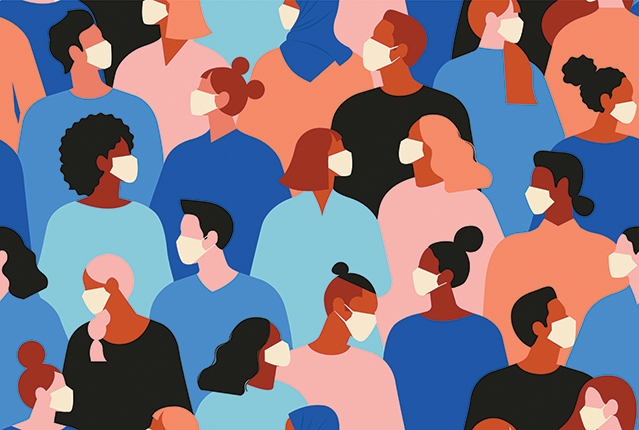
Although COVID-19 is a threat to everyone, people of color have been hit especially hard by the virus — what has been called a “pandemic within the pandemic.” African Americans and Hispanics in particular represent a disproportionate percentage of the deaths in many cities and states that track race and ethnicity data. In New York City, African Americans account for 33% of deaths from COVID-19 despite making up 22% of the population, and Hispanics and Latinos are dying at 1.6 times the rate of white people, according to New York City and New York State Department of Health data.
Experts say the toll of COVID-19 on these groups reflects longstanding inequalities tied to race and ethnicity in the United States, creating a perfect storm of risk factors in the COVID-19 pandemic.
“These are frightening numbers,” says Dr. Joy Deana Howell, assistant dean for diversity and student life and vice chair for diversity in the Department of Pediatrics, who specializes in pediatric critical care. “There are all of these intertwined societal factors that greatly impact access to care.”
‘Social Distancing is a Privilege’
Since March, government officials have ordered people to stay at home as much as possible to avoid contracting and spreading COVID-19 — a strategy that is still in force in most states – but not everyone can easily practice social distancing.
People of color more typically hold jobs that have been designated essential during the lockdown, in areas like public transit, building cleaning, childcare, and grocery store retail and delivery, according to data from the New York City Comptroller’s Office.
At home, they face greater risk too, as they’re more likely to live in denser and lower-income neighborhoods where dwellings are crowded and multiple generations are under one roof.
“At the level of exposure, there is a lot of inequality,” says Dr. Said Ibrahim, senior associate dean for diversity and inclusion. “Social distancing is a privilege."
Health Conditions and Trouble Accessing Quality Healthcare
These same groups are also more likely than the general population to suffer from the underlying medical conditions, like lung disease, heart disease, high blood pressure and obesity, which puts them at increased risk for death or severe illness if they contract COVID-19.
People of color also have greater trouble accessing the kind of quality care that can make the difference between life or death from COVID-19. Hospitals in poorer neighborhoods tend to have fewer resources. People of color are more likely than the general population to have Medicaid, which is not as widely accepted as other insurance because of often lower reimbursement rates. These groups may also have a harder time using telemedicine, which providers have turned to during the pandemic to triage COVID-19 symptoms, if they lack technological proficiency or tools like computers, smartphones, video call applications, or access to high-speed Internet.
Additionally, there is historical distrust among African Americans and others toward the healthcare system resulting from past mistreatment, and reports that members of these communities haven’t received proper care for coronavirus symptoms.
Identifying Patterns in Patients
To care for patients effectively and understand what is needed to lift economic restrictions, Weill Cornell Medicine researchers are studying patterns of risk and disease among people who have been treated for COVID-19.
Dr. Monika Safford, chief of the division of general internal medicine at Weill Cornell Medicine and NewYork-Presbyterian/Weill Cornell Medical Center and director of the Cornell Center for Health Equity, is working with a group of medical students in a fast-evolving effort to create a continuously updated registry of COVID-19 patients at NewYork-Presbyterian locations on the Upper East Side, Lower Manhattan, Queens, and eventually Brooklyn. The team has already extracted key information like race, underlying medical conditions, and where people live from the charts of over 1,300 patients.
“The diversity of patients being admitted to these hospitals is enormous,” says Dr. Safford. “This is a seminal effort that will help to inform how to take care of these patients in the best possible way.”
One of their key findings so far has been the role of obesity as a risk factor for more severe disease, and they are hard at work developing risk-prediction models to help clinicians recognize patients who may be stable initially but are at high risk of deterioration later. The group has already published its first report in the New England Journal of Medicine. A study on racial disparities in COVID-related mortality is now underway.
Short and Long-term Strategies
Though up against historic structural inequality, experts say there are many available short-term and long-term strategies to address the disparities in COVID-19 cases.
Dr. Ibrahim suggests making telehealth more accessible to people of color by allowing phone calls to be covered in addition to video streaming, and increasing Medicaid’s reimbursement for it. Prescription drug copays could be less expensive, so patients can manage their underlying conditions. And federal stimulus packages should include investment in public hospitals, he says, where African Americans and Hispanics are most likely to seek care.
Dr. Howell, who is also an associate attending physician at NewYork-Presbyterian/Weill Cornell Medical Center, also pointed to open letters by representatives, academicians, and others, calling on states to carefully review and potentially revise policies on triaging or rationing medical resources and staff in crisis situations, to ensure they’re not resulting in unequal care.
Deeper, more structural changes could include more training of people underrepresented in medicine and other health professions, and an insurance system that makes care more affordable and accessible.
“It’s one thing to address the immediate pandemic related issues,” says Dr. Ibrahim. “But then there's the need to really address the long-term issues, the solutions.”

